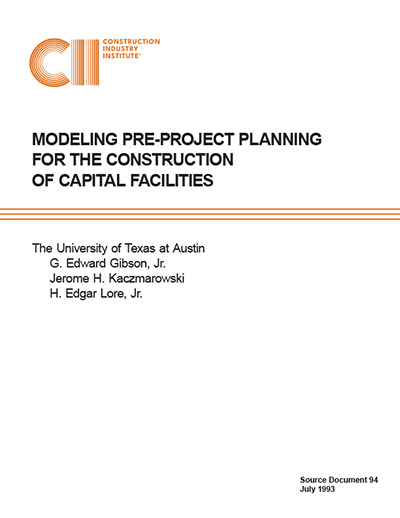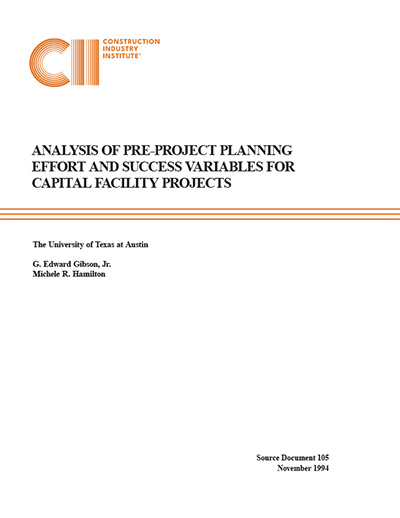
Modeling Pre-Project Planning for the Construction of Capital Facilities
Pre-project planning has a significant impact on the outcome of a construction project. CII assembled task force #39 to study pre-project planning in the construction of capital facilities. This source document presents a model that is the culmination of the first objective in a three-phased research project. The three task force objectives are:
- Model the pre-project planning process for the construction of capital facilities and develop a glossary of planning terms;
- Evaluate the relationship between project success and the level of pre-project planning effort; and
- Develop a handbook identifying the best pre-project planning practices.
The task force has defined pre-project planning as the process of developing sufficient strategic information for owners to address risk and decide to commit resources to maximize the chance for a successful project. The development of the pre-project planning model has led to several conclusions by the researchers. These conclusions are given below:
- Pre-project planning is a process that can be standardized. The function boxes in the pre-project planning model represent the steps necessary to formally pre-project plan a capital facility project. The four primary functions in pre-project planning are:
- Organize for pre-project planning
- Select project alternatives
- Develop a project definition package
- Decide whether to proceed with project
- The model presented in this document is a good generic representation of the pre-project planning process.
- The glossary presented in this document is a good basis for communicating the concepts of pre-project planning.
- The IDEF0 methodology is an effective process modeling tool when using group techniques in a task force setting.
In addition, it was found through interviews with industry professionals that:
- Pre-project planning is an owner driven process that must be tied closely to business goals.
- Pre-project planning is a complex process that must be adapted to the business needs of the company. Also, operations must be closely tied to pre-project planning early in the process. Although the researchers developed the model to be as generic as possible, companies must make modifications to meet their individual business needs.
- It is important that the corporate goals and guidelines for pre-project planning, and the project, are well defined and that there are key individuals who are empowered by management to act on those goals, as well as be accountable for their actions. This document consists of six primary sections. The first chapter gives an introduction to the pre-project planning model and the project in general.
Chapter two describes the IDEF0 methodology used by the task force to model the pre-project planning process, and chapter three describes the research methodology. Chapter four is a literature review that examines other pre-project planning models. Chapter five presents the model itself which consists of six diagrams, each with a narrative description and a glossary of terms. The sixth chapter describes the methods used to validate the model.
Finally, chapter seven presents conclusions and recommendations. The task force feels that the information given in this report is of sufficient caliber to be useful to companies developing and improving the pre-project planning process within their organizations.
The task force is currently working to identify the relationship between project success and the level of pre-project planning effort through an extensive survey of recently completed projects. In addition, the task force is currently developing a handbook for pre-project planning that will use the generic model presented in this report as a starting point to outline specific steps and tools for the planning of industrial construction projects.
This model breaks the project life cycle into four distinct stages: business planning, pre-project planning, execute project, and operate facility. The project planning phase includes the first two stages with a focus on stage 2 with these four steps:
- Organize for pre-project planning
- Select project alternatives
- Develop a project definition package
- Decide whether to proceed with project
The tasks are represented by the functional boxes in the pre-project planning model that is explained in the research. (SD-94, p.1)



